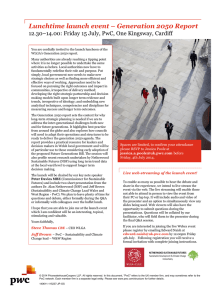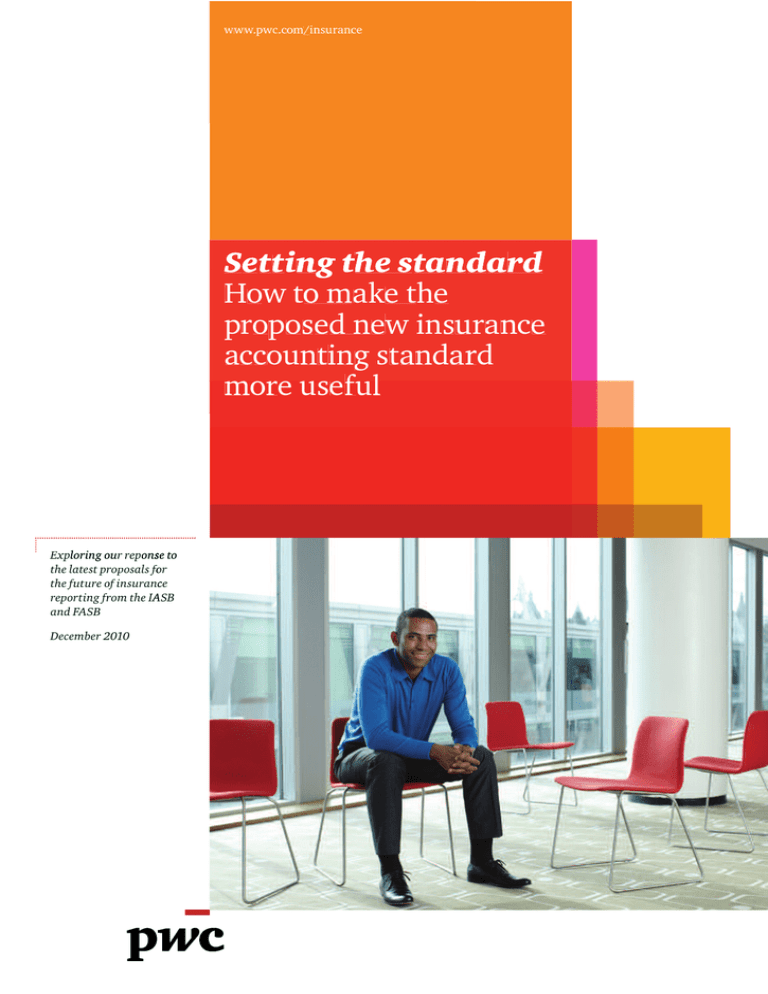
www.pwc.com/insurance
w
w w.pwc.com/insurance
Setting
S
etting tthe
he sstandard
tandard
How
H
ow tto
om
make
ake tthe
he
p
roposed n
ew insurance
insurance
proposed
new
a
ccounting sstandard
tandard
accounting
more
m
ore u
useful
seful
E x plor ing our reep
pon se to
the latest proposal s for
for
o
the ffu
uture o
off in surance
reeport ing ffrrom the IIA
A SB
a nd F
FA
A SB
December 2010
2 PwC Setting the standard
Contents
04
Executive summary
06
Summary of our comments on the proposed
measurement model
09
Our comments on other areas of the exposure draft
proposals
12
FASB involvement and convergence with US GAAP
13
Contact us
14
Recent insurance-related publications
PwC Setting the standard 3
Executive summary
Introduction
The development of the planned new IFRS for insurance contracts is an opportunity to
create a reporting framework capable of conveying to investors the true value being
created within insurance businesses. A consistent measurement of insurance contracts
will allow for comparison of insurers’ performance across different groups and
territories.
While some of the points in question might seem arcane, the final outcome of the
debate could have a crucial impact on the level and trajectory of insurers’ earnings and
how performance and prospects are judged by analysts and investors.
This paper summarises our comment letter on the latest proposals for the future of
insurance reporting published by the International Accounting Standards Board (IASB)
in July 2010. We’ve also outlined our additional comments on the discussion paper
(DP) published by the US Financial Accounting Standards Board (FASB) in September
2010, which seeks views on the IASB exposure draft (ED), as well as input on the
differences in views between the IASB and FASB in the insurance contract project.
In developing our response, we have taken account of the increasing use of IFRS
around the world and the resulting need to ensure that the proposals are relevant to a
wide range of contracts and companies in very diverse economies. Our responses drew
on in-depth surveys of practitioners specialising in the industry, along with discussions
with users, clients and insurers from around the world. Although the opinions of
different preparers and users of accounts can vary quite markedly, their perspectives
have provided valuable insights that have helped us to formulate our view, which we
believe represents a balanced and coherent approach to financial reporting for
insurance contracts.
Overview of our response
We appreciate the contribution that the IASB has made towards developing a
comprehensive model of accounting for insurance contracts. A comprehensive new
standard is essential as the transitional arrangements established in IFRS 4 (‘Phase 1’)
don’t provide the level of transparency and comparability that users of financial
statements need to make a fully informed evaluation of the
business. We believe the IASB’s proposal is a significant
improvement, which addresses many of the concerns over
‘…we recommend the Board
corporate reporting by insurers and is an improvement from
the current exit value concept in the previous IASB DP.
work closely with the insurance
industry to comprehensively test
the proposals…’
From PwC’s response to IASB exposure draft
4 PwC Setting the standard
We recognise that the proposed standard will bring about
pervasive changes to the way insurers measure and present
the results from issuing insurance contracts and we
encourage the boards to work closely with the insurance
industry to comprehensively test the proposals with real data
before finalising the standard.
Overall, we support the use of a measurement model for all
insurance contracts that portrays a current assessment of the
amount, timing and uncertainty of the future cash flows that the
insurer expects its existing insurance contracts to generate.
However, modification in a number of key areas would help to
make the model more relevant, reliable and workable for both
users and preparers of insurance accounts as summarised below
and set out in more detail in the subsequent sections.
Unbundling
We would prefer unbundling to only be required when the
economic characteristics and risks of the component aren’t
significantly interdependent with those of the host insurance
contract, but would support the optional unbundling of
significant interdependent account balances.
Transition
Key points
We disagree with not recognising any residual margin on
transition and would support full retrospective application
unless impracticable.
Discount rate
Presentation
While we support the use of a discount rate that reflects the
characteristics of the insurance contract liability, we realise that
the use of a discount rate that excludes credit risk may result in
the recognition of a day one accounting loss. We also support an
option to lock in the discount rate which could alleviate the
potential mismatch between insurance liabilities and assets held
to back them that are measured at amortised cost.
We support the summarised margin approach, but recommend
the disclosure of specific volume disclosures.
Risk adjustment
We conceptually agree with the need for a risk adjustment, but
we believe the IASB should work with users and preparers to
ensure that the recognition of an explicit risk adjustment will
provide decision-useful information.
FASB involvement and convergence
with US GAAP
We agree with preparers and users that existing US Standards
on accounting for insurance contracts are well understood and
produce relevant information in the markets that use US GAAP.
We don’t believe the targeted improvements would significantly
improve current US GAAP and believe it would be more efficient
for FASB to work with the IASB towards converged financial
instrument and insurance contract standards to warrant its
adoption in the US.
Residual margin
We support the use of a residual margin to avoid an initial profit.
However, we have concerns as to whether the amortisation
method and recognition of changes in estimates will recognise
the profit on a contract in an appropriate manner.
Short duration contracts
The modified measurement approach for short duration
contracts should be permitted but not mandated and available
for contracts of more than 12 months duration.
PwC Setting the standard 5
Summary of our comments
on the proposed measurement
model
Introduction
The IASB’s proposals for the measurement of insurance contracts were outlined in the
ED that was issued on 30 July 2010. We summarised the main proposals in our
Practical Guide to IFRS, issued on 23 August 2010.
In the three years since the publication of the IASB’s DP, both boards, the industry and
ourselves have been continuing to discuss the accounting for insurance contracts. As a
result of these discussions some of our views have changed and we’re also pleased to
note that a lot of our comments on the IASB’s DP proposals have been reflected in the
ED. In our response to the IASB on the ED we support the use of a fulfilment objective
of a current value measurement that assumes performance according to the terms of
the contract rather than an exit model. However, while we support the IASB proposal
overall, we also have some concerns about certain aspects of the proposed
measurement model.
Discount rate
We agree that the discount rate used by the insurer should reflect the characteristics of
the insurance contract liability. We believe that in a measurement model with a
fulfilment objective the discount rate should not reflect the issuer’s own credit risk.
The exclusion from profit and loss of the changes in the measurement of a liability due
to changes in an entity’s own credit risk in circumstances where they’re not expected to
be realised by transfer to a third party is also consistent with the conclusions reached
by the IASB in their recent project on financial liabilities. While we support the use of
the risk free rate with an adjustment for illiquidity, we note that in some instances the
exclusion of the issuer’s own credit risk from the discount rate may result in the
recognition of a day one accounting loss. However it’s unclear to us whether this will
occur often enough to cause concern. We believe the boards should assess the
prevalence and significance of such apparently uneconomic outcomes to determine
whether an exception to the overall model is warranted. Alternatively, the IASB may
find that the concerns can be addressed through additional disclosure.
‘…allow insurers an option to
apply a locked-in discount rate…’
From PwC’s response to IASB exposure draft
6 PwC Setting the standard
We agree with the adjustment of the discount rate to reflect
the liquidity characteristics of the insurance contract. The
holder of a government bond effectively acquires a nontradeable investment and an embedded option to sell the
instrument (for which the holder pays a premium through a
reduction in the return). For insurance contracts that cannot
be put back to the insurer, the discount rate should equal the
higher return on a non-tradeable investment.
At the time the IASB’s DP was issued and during the IASB’s
deliberations on the discount rate, there was general consensus
that accounting for financial instruments would predominantly
follow a fair value measurement model. However, in the
development of IFRS 9, ‘Financial Instruments’, the IASB has
concluded that amortised cost is a valid measurement approach
for certain financial assets if the aim of the holder is to collect
the contractual cash flows under the contract. The use of a
current discount rate to measure insurance contracts will
introduce an accounting mismatch in the income statement if
insurers use amortised cost for many of the assets backing the
insurance liability. To alleviate this potential concern, we believe
insurers should be allowed an option to apply a locked-in
discount rate as established at the inception of the contract.
This option, applied at a portfolio level, should be available if it
eliminates or reduces an accounting mismatch and is consistent
with the insurer’s business model of fulfilling the contracts.
Risk adjustment
Whether or not to include an explicit risk adjustment in the
measurement of insurance contracts is a very difficult issue.
Some of the advantages that we considered when we debated
the merits of including an explicit risk adjustment are that it
provides decision useful information about the uncertainty
included in the judgemental cash flow estimates and the fact
that risk adjustment will be updated for changes in the price and
quantity of risk included in those estimates. Not only does an
explicit risk adjustment better reflect skewed tail distributions,
its inclusion in the measurement of the liability also lessens the
amount of residual margin which is subject to the complexities
of amortisation and potentially remeasurement. An added
benefit for insurers in some jurisdictions is the closer alignment
with the regulatory regimes that also require the calculation of
explicit risk adjustments.
‘…work closely with the insurance
industry to understand the
practical implications and
operationality of both the
explicit risk adjustment and the
alternative composite margin
model…’
From PwC’s response to IASB exposure draft
However, these benefits are offset by the potential lack of
comparability and consistency without introducing rules for the
calculation of the risk adjustment and this may lead the users
of the financial statements to not trust the explicit risk
adjustment calculations. We also debated whether the objective
of the risk adjustment can be consistent with the overall
fulfilment objective of the measurement model. We considered
whether the inclusion of a risk adjustment would be cost
beneficial for all sized companies and also considered whether
it could be implemented given the time constraints imposed by
reporting timelines.
The IASB and FASB also struggled with this aspect of the
measurement model and came to different conclusions. On
balance, we concluded that we would conceptually support
the inclusion of an explicit risk adjustment in the measurement
of an insurance contract at the portfolio level. However, we’re
concerned that the proposed model may not produce
comparable results among insurers and that the proposed
amortisation methods for both the residual margin (in the risk
adjustment model) and the composite margin (in the alternative
model proposed by FASB) may not recognise the income on a
contract in an appropriate manner. We believe the IASB should
work with users to ensure that the recognition of an explicit risk
adjustment will provide sufficient decision-useful information
to make this approach cost beneficial to adopt.
We believe the standard should provide the principle for the risk
adjustment and allow for the use of any risk adjustment
technique that complies with the objective. This will allow the
use of more appropriate and reliable methods to calculate the
risk adjustment that may be developed over time. However, we
believe that insurers should use a consistent methodology within
group financial statements to calculate the risk adjustment for
all similar contracts. We don’t support the disclosure of
confidence level information as a ‘comparable benchmark’ as
this could be misleading when the pattern of your claims is not a
normal distribution.
Residual margin and reporting changes in
circumstances
We supported the recognition of a net day one gain at the IASB’s
DP stage because the gain results from agreeing the contractual
terms and conditions and is independent of any release from
risk. Although that is still a valid argument, we now agree that
no gain should be recognised at the initial recognition of an
insurance contract. This is consistent with our support for the
proposals in the revenue recognition ED and IAS 39 for financial
instruments that are valued using non-market observable inputs.
We also took into consideration the findings in our 2009 survey
of insurance analysts where three-quarters of participants were
opposed to the recognition of profit at the inception of the
contract.
PwC Setting the standard 7
When the measurement model proposed by the IASB is applied,
the residual margin will reflect items such as non-incremental
acquisition costs, general overheads and profit margins which
are included in pricing the contract but which are not reflected
in any of the other building blocks in the measurement model.
Given the myriad of items that end up being reflected in the
residual margin, we don’t agree with the principle that the
residual margin should be recognised in a manner that reflects
the probability of incurring a claim, as this is incorporated in the
explicit risk adjustment. Without the benefit of field testing,
we’re unable to propose a specific amortisation pattern, but
would support the recognition of the residual margin in the
income statement over the coverage period in a pattern that is
reflective of the time value of money, without the accretion
of interest.
‘The pattern for the release of the
residual margin will significantly
impact the earnings pattern of
some insurers.’
From PwC’s response to IASB exposure draft
Taking changes in estimates immediately to the income
statement will increase volatility which may raise concern from
users about an entity's performance over both the short and long
term. We would support recalibrating the residual margin at
each reporting period using updated cash flow estimates with all
current information (including the actual cash flow experience
to date) discounted at the original discount rate. The residual
margin would be recalibrated (remeasured) as at inception of
the contract and amortised over the coverage period using
updated information and assumptions of future cash flows.
This treatment would allow the remaining residual margin and
its release to represent the current expected future profit on the
contract at the reporting date. If a contract becomes onerous
subsequent to issuance, we do not believe that recognising the
entire change in estimates in the current period income
statement followed by the continued amortisation of profits
from the release of the locked in residual margin in subsequent
periods provides useful information. However, we acknowledge
that insurers may find the subsequent recalibration of the
residual margin operationally challenging and therefore the
IASB should work closely with the industry to ensure such a
recalibration approach can be practically applied.
8 PwC Setting the standard
Short duration contracts
We believe the modified measurement approach for short
duration contracts should be permitted but not mandated as
some insurers may find it operationally easier to apply the full
model to all of their contracts rather than to have two different
accounting methodologies. We also don’t believe the criteria for
the use of the simplified measurement should be limited to a
coverage period of approximately 12 months or less. For
example, if an insurer issues a 24 month contract and does not
expect the distribution of expected cash flows of future claims to
change because new information will not become available or
the distribution rarely changes, it should be permitted to apply
the simplified measurement model. However, we would support
permitting the use of the modified measurement approach for
all 12 month contracts as a practical expedient.
Our comments on other areas of
the exposure draft proposals
Unbundling
We believe it’s appropriate that insurers unbundle some components included in an
insurance contract in limited circumstances. Having worked though the proposals in
the ED, we are unclear on what the IASB meant by ‘closely related’ as this term is not
defined. We also believe the interplay between the principle and the examples in
analysing product features should be clarified. For example,
it is unclear whether insurers will be required to unbundle
an account balance that does not meet any of the specified
‘…an insurance contract is
unbundling criteria but is considered not to be closely
difficult or sometimes impossible
related to the host insurance contract.
to analyse and separate into its
individual parts…’
Given that most components in insurance contracts are
interdependent, we would prefer if unbundling were only
required when the economic characteristics and risks of the
component aren’t significantly interdependent with those of
From PwC’s response to IASB exposure draft
the host insurance contract. This is likely to mean that most
insurance contracts would not be unbundled. We believe
this would eliminate the potential "bundling" of two noninterdependent contracts with the same customer if they are closely related activities,
for example, where claims administration services and stop loss insurance coverage are
combined in a single contract. We would support the optional unbundling of
interdependent account balances in insurance contracts to enable, for example, loans
that are waived on death to be unbundled.
Investment contracts with discretionary
participating features
Consistent with our views on the IASB’s DP, we don’t believe that investment contracts
with discretionary participation features should be in the scope of the insurance
contracts standard in the longer term as they don’t transfer significant insurance risk.
However, while we believe these should be accounted for as financial instruments, we
realise that insurers would be faced with significant complexity and operational
challenges in applying the current financial instrument accounting to these contracts,
particularly in relation to IAS 32. We drew the IASB’s attention to the fact that these
contracts comprise a significant proportion of life insurers’ business in some countries
and that they should therefore consider the treatment of investment contracts with
discretionary participation features within the financial instruments with
characteristics of equity project. However, due to the IASB’s decision not to issue an ED
on that project in the near future, we recommend that these contracts are all included
within the scope of the insurance contracts standard as an interim measure.
PwC Setting the standard 9
Financial guarantee contracts
Boundary of the contract
It all depends on who you talk to… In our discussions with
insurers that write credit insurance business, it’s clear they don’t
for a minute believe these contracts should be outside the scope
of the insurance standard. However, talking to their banking
counterparts that issue both credit derivatives and financial
guarantee contracts, they don’t distinguish between the two
types of contracts in any way. They perceive the risk arising on
the two contracts in the same way.
We agree with the contract boundary principle proposed by the
IASB. In most circumstances insurers will be able to consistently
apply the proposed principle because it relies on the rights and
obligations contained in the contract and it should result in a
sensible contract term. At the IASB’s DP stage we supported a
principle that includes all estimated future contractual cash
flows that have commercial substance (those that the insurer
can expect to receive or pay during the period of the contract
when it is in the policyholder’s interests to continue to make
payments). However, we recognise that the insurance industry
has worked with the IASB to determine the current definition
of the contract boundary that reflects the substance of its
contracts.
On balance and after much debate we concluded that we don't
believe that contracts that are currently defined as financial
guarantee contracts should be within the scope of the insurance
standard. Conceptually, we believe credit risk arising from a
failure to pay is a type of financial risk and so should be
addressed using an expected loss accounting model as part of
the IASB’s financial assets impairment project. However, we
recognise that this solution will be a concern for credit insurers
and suggest that the IASB consults further with them to identify
whether these products can be distinguished in some way from
those more commonly issued by banks or other entities. An
advantage of including these contracts in the financial asset
impairment project is that group companies that enter into intragroup financial guarantees will not be required to use the
insurance contract measurement model.
However, we believe the IASB should clarify how the proposed
boundary of the contract principle should be applied when the
insurer's ability to underwrite individual policyholders and/or to
set premium rates are subject to external regulatory constraints.
For example, for certain types of healthcare contracts, insurers
may not have a legal right to underwrite a policyholder based
on his/her individual health risk and applying the contract
boundary proposals these contracts would not be short duration
contracts. We also note that the inclusion of payments to future
participating policyholders contradicts the boundary of the
contract principle.
Transition
Although we support the IASB’s proposal that the standard
should be applied retrospectively, we don’t support its proposal
not to recognise any residual margin for contracts in existence on
transition to the new standard. For those insurers that issue long
duration contracts, sometimes in excess of 30 years, the
proposals will result in no profit being recognised in the income
statement other than the release of the risk adjustment and we
do not believe this will faithfully present the performance of
the business in future years. We therefore support full
retrospective application of the proposed model with the
IAS 8 impracticability exemption. Although this proposal may
be challenging we didn’t identify any other proposal that was
conceptually sound and which would result in consistency and
comparability between different insurers. If however full
retrospective application is impracticable, we agree with
excluding any residual margin on contracts in existence on
transition.
‘Such an approach would distort
an insurer’s reported income for
years into the future.’
From PwC’s response to IASB exposure draft
10 PwC Setting the standard
Presentation and disclosure
We continue to believe that the summarised margin approach
will be useful to users as it reflects the building blocks
measurement model. However, further consideration should be
given to presentation when a business issues insurance contracts
while also undertaking significant non-insurance activities.
Corporate reporting by insurers today includes a number of
different performance measures. However, the lack of
consistency of this information among competitors significantly
reduces the comparability and therefore, to an extent, the
usefulness of this information. We therefore recommend that
the IASB specify the disclosure of volume measures, such as
annualised premium equivalent or gross written premium, to
improve the consistency of performance measures presented
to users.
While we believe it is useful to allow an expanded presentation
of the underwriting margin for short duration contracts in the
income statement, the standard should state whether
differences in the initial estimate of claims incurred are
presented in the claims incurred line within the underwriting
margin or in the experience adjustment line.
Reinsurance
We support the proposed use of an expected loss model for
reinsurance assets as it is consistent with the insurance contract
expected cash flow model. However, we don’t support the
recognition of an initial gain by a cedant on entering into a
reinsurance contract. In keeping with the proposals for
underlying insurance contracts and other standards, we would
defer the recognition of any day one gain except when the gain
offsets a loss recognised at inception of an onerous contract.
We are concerned that this proposal could encourage the
structuring of reinsurance transactions to allow cedants to
recognise immediate gains on entering into a reinsurance
contract.
‘…this could encourage the
structuring of reinsurance
transactions…’
From PwC’s response to IASB exposure draft
Acquisition costs
We believe that a mismatch between acquisition costs incurred
and premiums charged to reimburse these costs should be
avoided where possible. In a model that recognises day one
gains, as previously proposed in the DP, we supported the
recognition of acquisition costs in the income statement when
incurred due to the inherent reimbursement of these costs that
are included in future premiums that would implicitly be
recognised as part of that day one gain. Given the explanation
above as to why we no longer support the recognition of day one
gains, we believe insurers should not recognise a loss at
inception of the contract due to the treatment of acquisition
costs unless the contract is onerous. We therefore support the
ED proposals to treat incremental acquisition costs as a
contractual cash flow. We considered whether the proposals
could be broadened to include non-incremental acquisition costs
but, like the IASB, struggled to determine a principle that could
be applied consistently in practice. We are also mindful of the
fact that the restriction to acquisition costs incremental at
the contract level is consistent with accounting for financial
instruments.
PwC Setting the standard 11
FASB involvement and
convergence with US GAAP
We agree with preparers and users that existing US Standards on accounting for
insurance contracts are well understood and produce relevant information in the
markets that use US GAAP. Thus we believe the boards need to resolve their remaining
differences on this project and finalise one converged financial instrument standard,
in order for a proposed insurance contracts accounting standard to be sufficiently
beneficial to warrant its adoption in the US. We don’t believe the targeted
improvements would significantly improve current US GAAP and believe it would
be more efficient for FASB to work with the IASB as it field tests and re-deliberates
the proposals.
‘We believe that convergence to
a single set of high quality
accounting standards will benefit
the global capital markets…’
From PwC’s response to FASB discussion paper
12 PwC Setting the standard
Contact us
If you would like to discuss any of the issues raised in this paper, please call one of the following or speak with your usual
contact at PwC.
Authors
Gail Tucker
Donald Doran
PwC (UK)
gail.l.tucker@uk.pwc.com
+44 (0) 117 923 4230
PwC (US)
donald.a.doran@us.pwc.com
+1 646 471 1900
Contacts
C
C
David Law
Dominic Nixon
Jim Scanlan
Global Insurance leader
PwC (UK)
david.law@uk.pwc.com
+44 (0) 7710 173556
PwC (Singapore)
dominic.nixon@sg.pwc.com
+65 6236 3188
PwC (US)
james.j.scanlan@us.pwc.com
+1 267 330 2110
Scott Hadfield
Lloyd Bryce
Alex Finn
PwC (Australia)
scott.hadfield@au.pwc.com
+61 2 8266 1977
PwC (Hong Kong)
lloyd.bryce@hk.pwc.com
+852 2289 2712
PwC (UK)
alex.w.finn@uk.pwc.com
+44 (0) 207 212 4791
Kenneth Vermeire
Peter Whalley
John Althoff
PwC (Belgium)
kenneth.vermeire@be.pwc.com
+32 2 710 9770
PwC (Hong Kong)
peter.whalley@hk.pwc.com
+852 2289 1192
PwC (UK)
john.m.althoff@uk.pwc.com
+44 (0) 207 213 1175
Philippe Thieren
Minoru Kawabata
Trevor Lewin
PwC (Canada)
philippe.thieren@ca.pwc.com
+1 514 205 5377
PwC (Japan)
minoru.kawabata@jp.pwc.com
+81 90 6490 9296
PwC (UK)
trevor.j.lewin@uk.pwc.com
+44 (0) 20 7212 4088
Michel Laforce
Andre Rohayem
Andrew Hill
PwC (France)
michel.laforce@fr.pwc.com
+33 1 56 57 1082
PwC (Middle East)
andre.rohayem@lb.pwc.com
+961 1 200577
PwC (US)
a.g.hill@us.pwc.com
+1 646 857 0508
Stéphane Kuypers
Albert Zoon
Mary Saslow
PwC (France)
stephane.kuypers@fr.pwc.com
+33 1 56 57 1283
PwC (Netherlands)
albert.zoon@nl.pwc.com
+31 887 925 233
PwC (US)
mary.saslow@us.pwc.com
+1 860 241 7013
Alexander Hofmann
Ilse French
Sam Gutterman
PwC (Germany)
alexander.dieter.hofmann@de.pwc.com
+49 211 981 7408
PwC (South Africa)
ilse.french@za.pwc.com
+27 11 797 4094
PwC (US)
sam.gutterman@us.pwc.com
+1 312 298 3647
David Bacher
Enrico Strozzi
PwC (Germany)
david.f.bacher@de.pwc.com
+49 89 5790 5557
PwC (Switzerland)
enrico.strozzi@ch.pwc.com
+41 58 792 2464
For more information about ‘Setting the standard’, please contact Rebecca Pratley, Head of Insurance Marketing, PwC (UK) on
+44 20 7804 3749 or at rebecca.j.pratley@uk.pwc.com
PwC Setting the standard 13
Recent insurance-related
publications
w
w w.pwc.com/insurance
www.pwc.com/insurance
G
etting tto
o
Getting
g
rips w
ith tthe
he
grips
with
sshake-up
hake-up
While the ssyy nerg ies bet ween
c y IIII
the emergging Solvency
and IFR S ffrramework s will
allow in surerss to develop
a common reep
port ing
plat for
o m, there are bound
to be some sig nificant
dif ferences. In thi s
publicat ion we e xamine
the dif ferences and
similar it ies bet ween the
t wo fr
f ramework s and start
to a s s e s s h o w t h i s w i l l
af fect reep
port ing ssyystem s,
management evaluat ion
and market communicat ion.
October 2010
Practical guide to IFRS –
Insurance contracts
August 2010
This publication explores the proposed
standard and the implications following
the release of the
IASB’s exposure draft on insurance
contracts on 30 July 2010.
First steps and challenges
in implementing Solvency II
and IFRS in parallel
October 2010
PwC Solvency II and IFRS specialists have
come together to review the first steps
and challenges in implementing Solvency
II and IFRS in parallel. This new thought
leadership examines the key
similarities and differences between
IFRS and Solvency II in the areas of
measurement of contract liabilities,
measurement of assets and other
liabilities, disclosures and group
consolidation and provides a technical
comparison.
14 PwC Setting the standard
This publication has been prepared for general guidance on matters of interest only, and does not constitute professional advice. You should not act upon the
information contained in this publication without obtaining specific professional advice. No representation or warranty (express or implied) is given as to the accuracy or
completeness of the information contained in this publication, and, to the extent permitted by law, PricewaterhouseCoopers does not accept or assume any liability,
responsibility or duty of care for any consequences of you or anyone else acting, or refraining to act, in reliance on the information contained in this publication or for any
decision based on it.
pwc.com/insurance
© 2010 PwC. All rights reserved. Not for further distribution without the permission of PwC. “PwC” refers to the network of member firms of PricewaterhouseCoopers
International Limited (PwCIL), or, as the context requires, individual member firms of the PwC network. Each member firm is a separate legal entity and does not act as
agent of PwCIL or any other member firm. PwCIL does not provide any services to clients. PwCIL is not responsible or liable for the acts or omissions of any of its
member firms nor can it control the exercise of their professional judgment or bind them in any way. No member firm is responsible or liable for the acts or omissions of
any other member firm nor can it control the exercise of another member firm’s professional judgment or bind another member firm or PwCIL in any way.

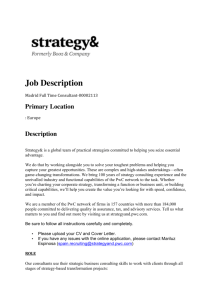
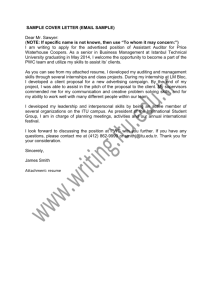

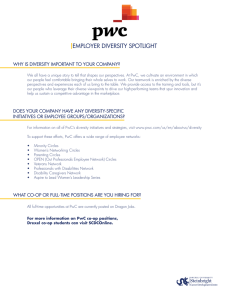
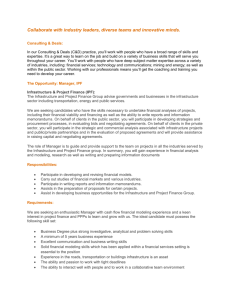
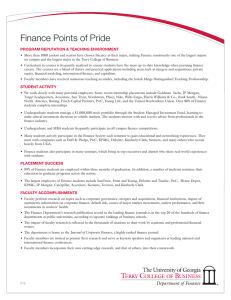
![(On client's letterhead) [Debtor] – [Address]](http://s2.studylib.net/store/data/015619376_1-634457b7baedfa32fb5e3856cbcd37b7-300x300.png)
